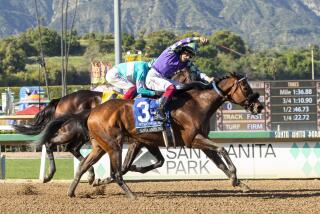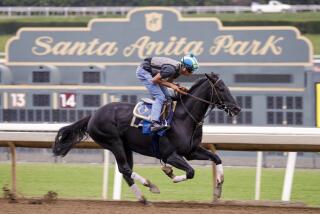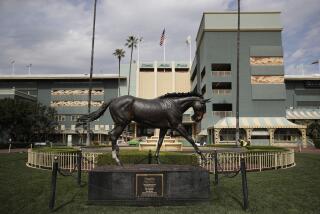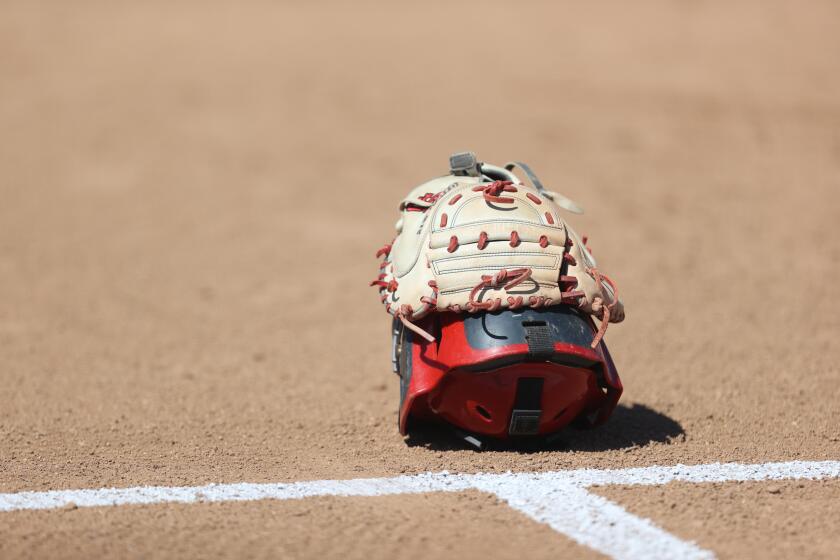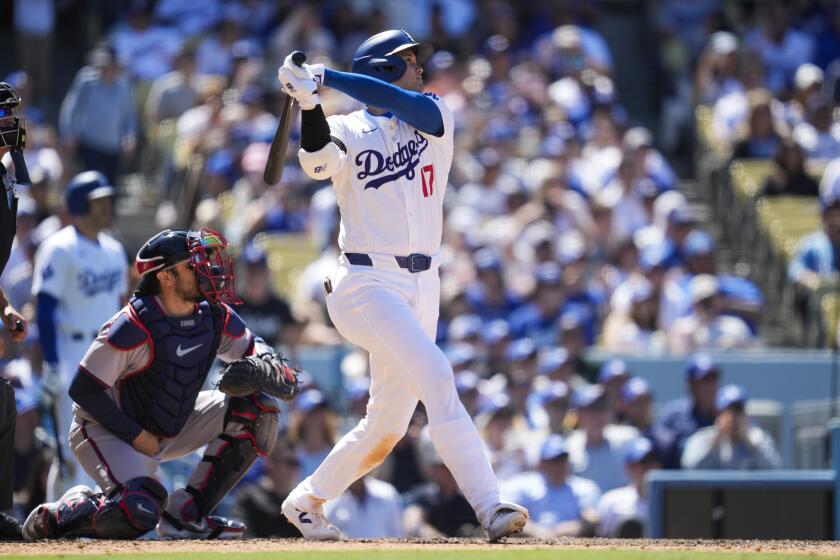It was always a good day at the races
IN 1982, there was a wonderful documentary film about the Weavers, the blacklisted folk singers, subtitled, “Wasn’t That a Time!” Wistful California racetrack operators could use the same words to describe the so-called golden age of horse racing, which had an incredibly long run, arguably until the 1980s, before the start of a downward spiral that grips the sport still.
Charlie Whittingham, the Hall of Fame trainer who heavily contributed to the palmy days, took time to reflect in the mid-1990s by saying, “Those times are long gone. And we’ll never see them again.”
Southern California’s three main tracks opened in the 1930s and are rich in history, but only one of the three continues to thrive today.
FOR THE RECORD:
Racehorse: In Sports’ 125th anniversary section Thursday, an article on Seabiscuit said a film about the horse was released in 2004. “Seabiscuit” was released in 2003. —
In Sports’ 125th anniversary section on March 30, an archival photo was identified as a scene from the 1940 Santa Anita Handicap showing Seabiscuit holding off Kayak II. According to Santa Anita, it is not from a race but, instead, shows a public workout between two Charles Howard-owned horses on an undetermined date. The jockeys were identified in the caption as Red Pollard and Leon Haas. However, the jockey on the lead horse is Johnny Adams. The identity of the second jockey could not be confirmed.
Whittingham, who was 86 when he died in 1999, was there for many of the huzzahs. He trained 11 national champions, including Kentucky Derby winners Ferdinand and Sunday Silence. One race he didn’t win was the 1982 Santa Anita Handicap. Whittingham thought his Perrault had beaten the vaunted John Henry, only to see the stewards disqualify the horse for interference in the stretch. The crowd of 75,752 roared when John Henry was declared the winner, the first horse to win the Big ‘Cap twice in a row.
Milwaukee Brew won two consecutive Big ‘Caps two decades later. But the combined attendance for those two races, in 2002 and 2003, was only 56,000.
The most recent Santa Anita Handicap, won by Lava Man this month, drew 49,000, and track executives, compelled to set the bar lower than their predecessors, were cakewalking over the turnout. It was the largest attendance at Santa Anita, other than for a Breeders’ Cup day, in 16 years.
Canadian industrialist Frank Stronach, who raced Milwaukee Brew, bought Santa Anita for $126 million in 1998. He had grandiose plans, such as recapturing the era that Whittingham treasured, but Santa Anita remains a work in progress.
Across town, the clock is ticking for Hollywood Park, the track that Seabiscuit put on the map when he won the first Hollywood Gold Cup in 1938.
The Bay Meadows Land Co., in San Mateo, bought Hollywood for $260 million in 2005 and plans to commercially redevelop the property if the state doesn’t legalize slot machines in a few years. Slots were tossed out in a state-wide referendum in 2004.
Of Southern California’s three major tracks, only Del Mar continues to prosper. Bing Crosby’s 1937 invention, which had an $80-million face-lift in the early 1990s, was the site of one of the sport’s biggest upsets — the end of Cigar’s 16-race winning streak when the unsung Dare And Go beat him in the Pacific Classic in 1996.
Some of the sport’s legendary jockeys thrived in Southern California. Bill Shoemaker, at 23, won 94 races in 41 days at Del Mar in 1954, on the way to a record-setting total of 8,833. Laffit Pincay surpassed Shoemaker’s record in 1999, and had reached the 9,530 mark when he broke his neck in a career-ending spill at Santa Anita in 2003.
A 1991 automobile accident left Shoemaker a quadriplegic and curtailed his career as a trainer. He died, at 72, in 2003, eight months after the passing of Johnny Longden on his 96th birthday. Longden posted his 6,032rd and final win aboard George Royal in Santa Anita’s emotionally charged San Juan Capistrano Handicap in 1966.
Seabiscuit left his stamp on Santa Anita as well. Twice he had been narrowly beaten in the Santa Anita Handicap, but in 1940, at the age of 7, he out-finished stablemate Kayak II to thrill a crowd of 68,526. Seabiscuit, who never ran again, was the subject of a runaway bestseller that was made into a film in 2004.
Santa Anita was turned into a detention camp for three years during World War II, but racing in the 1950s was buoyed by the West Coast arrival of Citation, the 1948 Triple Crown champion. The Calumet Farm product’s 16-race winning streak ended at Santa Anita in 1950, but the next year, in the final race of his career, Citation became the first horse to earn $1 million by winning the Hollywood Gold Cup. The decade’s encores were earned by Swaps, who won the Santa Anita Derby before winning the Kentucky Derby in 1955; and Round Table, who as a 3-year-old won the Hollywood Gold Cup in 1957 and the Santa Anita Handicap a year later. Swaps, who in 1956 became California’s first horse of the year, drew 62,572 to Hollywood Park in his first start after the Kentucky Derby.
Shoemaker rode Swaps, Round Table, John Henry and Ferdinand. He rode Native Diver early on, before the California-bred gelding won three Hollywood Gold Cups with Jerry Lambert in the irons. Native Diver won the Gold Cup in 1965, 1966 and 1967. Less than two months after his third win, the 8-year-old won the Del Mar Handicap; he died nine days later of complications from an intestinal infection.
The first Breeders’ Cup, in 1984, was held at Hollywood Park, and there have been two others there and three at Santa Anita. In 2003, in 99-degree heat at his home track, the Santa Anita-based trainer, Richard Mandella, won four of the eight races, capping the day with a victory by Pleasantly Perfect in the $4-million Classic.
Spectacular Bid was born too soon for the Breeders’ Cup, but from 1978 into 1980 he found enough national stages to earn four Eclipse Awards, including one horse-of-the-year trophy. When ridden by Shoemaker, the pewter-gray colt was beaten only once in 13 races, including a six-for-six streak at Santa Anita and Hollywood Park in 1980. Shoemaker said that Spectacular Bid was the best he rode. That covered a lot of horseflesh.
More to Read
Get our high school sports newsletter
Prep Rally is devoted to the SoCal high school sports experience, bringing you scores, stories and a behind-the-scenes look at what makes prep sports so popular.
You may occasionally receive promotional content from the Los Angeles Times.
